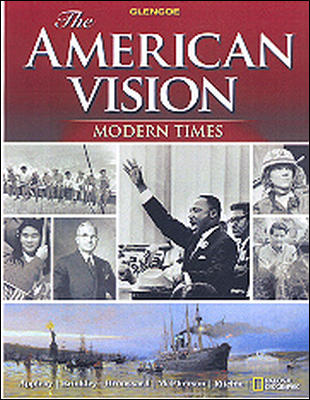
The American Vision Modern Times © 2010Chapter 5: Industrialization, 1865-1901Chapter OverviewsThis chapter looks at how the United States became an industrial power after the Civil War and how new technologies and new ways of working impacted Americans' lives. Section 1 discusses the factors that contributed to the industrialization of the United States in the late 1800s. With an abundance of natural resources and able workers, the United States turned its focus to technology and industry after the Civil War. Entrepreneurs and European investors financed industries and a flood of new inventions that transformed American communications and manufacturing and improved transportation. In the late 1800s, the federal government's laissez-faire approach—low taxes, low spending, and little interference—fostered the growth of free enterprise. At the same time, the government's high tariffs encouraged American industrial growth by reducing demand for foreign goods. As industry expanded, millions of Americans left their farms to work in mines and factories. By the early 1900s, American entrepreneurial skill and technology had transformed the United States into the world's leading industrial nation. Section 2 describes how the rapid construction of railroads after the Civil War spurred the nation's industrial growth. With the Pacific Railway Act in 1862, the nation set off on a mission to connect its distant regions in a transportation network. The transcontinental railroad was the first of many lines to crisscross the nation. Eventually, railroad consolidation connected hundreds of small railway lines across the country, making the transportation of goods more efficient and economical. Railroads revolutionized transportation, broadened markets, and stimulated the economy. The federal government helped finance railroad construction by giving many railroad companies land grants. Corruption plagued the land grant system, and robber barons reaped huge profits from manipulating the system. Section 3 follows the rise of large corporations and how they came to dominate American business. During the late 1800s, corporations developed new technologies and built large manufacturing facilities. Because corporations increased manufacturing productivity and decreased production costs, they were able to operate even in poor economic times. Small companies who could not compete were forced out of business, and by the 1870s many industries were dominated by a few large corporations. Shrewd corporate leaders used company mergers to build huge empires. Laws designed to prevent monopolies did not address trusts or holding companies, and corporations grew even larger. New methods of selling introduced consumers to the products of American industrialization. Section 4 traces the growth of American labor unions. In the late 1800s industrial workers labored long hours under difficult, often dangerous, conditions. Many workers decided to improve their situations by organizing trade and industrial unions. Union organizers, however, found opposition in employers, the courts, and those who thought unions threatened basic American institutions. Confrontations with owners and government often led to violence and federal intervention. While industrial unions generally failed, trade unions—unions limited to people with specific skills—survived. The leader of one trade union, the AFL, helped unions become acceptable in American society. Women, who were excluded from most unions, organized their own unions to promote women's labor issues. Despite their gains, unions remained relatively weak as the 1900s began. |  |















